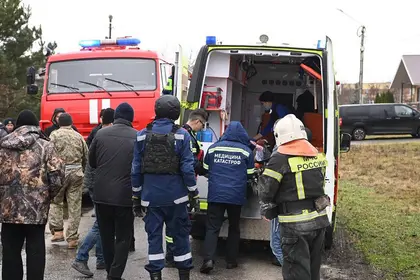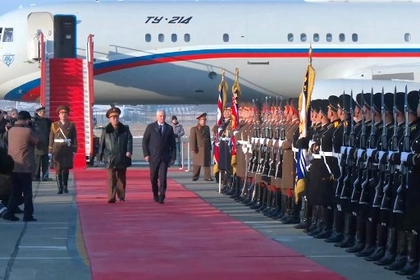Elements of the Western media are directly echoing the Kremlin’s narrative or resorting to the classic get out of “balanced” reporting that fails to highlight the real differences in the nature of the recent cross-border attacks. This presents a skewed picture of the events that buries the truth and helps Russia.
Following the unprecedented wave of air strikes against Ukraine, likely triggered by Ukraine’s continuing attrition of Russia’s Black Sea Fleet, Moscow claims that Ukraine attacked civilian targets deliberately in the city of Belgorod and its regional villages.
JOIN US ON TELEGRAM
Follow our coverage of the war on the @Kyivpost_official.
The governor of the Belgorod Region’s governor, Vyacheslav Gladkov, said on Wednesday: “The situation in Belgorod is tense. In the morning there were two attacks. The air defense system worked… Our air defense system worked over Belgorod and the Belgorod district – several air targets were shot down on the approach to the city.”
On Tuesday UN human rights chief Volker Turk called for an immediate de-escalation of hostilities between Russia and Ukraine as his office voiced alarm at the intensification of attacks.
Radio Free Europe/Radio Liberty (RFE/RL) wrote:
Deadly strikes hit residential buildings in Ukraine and a Russian border region on Tuesday as waves of aerial attacks also wounded dozens and prompted Kyiv to urge speedier Western weapons shipments.

Luxury Western Goods Line Russian Stores, Three Years Into Sanctions
“Alarming escalation of hostilities, dozens of civilians killed in Ukraine and Russia. International humanitarian law prohibits indiscriminate attacks and attacks against civilian objects,” the UN Human Rights Office said on X (formerly Twitter).
“Volker Turk urges immediate steps to de-escalate, ensure protection of civilians and respect international law.”
Online headlines in the Western press about the recent cross-border attacks include:
- “Ukrainian Missile Attack on a Russian City Kills at Least 22, Officials Say” – New York Times
- “Ukraine Ushers in 2024 As Deadly Missile Strikes Hit Both Sides of Border” – RFE/RL
- “Wave of Russian strikes on Kharkiv after Ukrainian attack on Belgorod” – The Guardian
- “Ukraine war: Missiles fired at Russian city Belgorod and occupied Crimea” – The BBC
- “Russia-Ukraine war: Putin calls Ukrainian strikes on Belgorod ‘terrorist act’ that ‘will not go unpunished’ – as it happened” – The Guardian
- “UN Urges Immediate Russia-Ukraine De-Escalation” – AFP by way of Kyiv Post
The Western press has been accepting and posting handout pieces from the Russian authorities, including photos purporting to be villages on fire. Some will mention that the material was provided by Moscow and suggest that they have fact-checked the veracity. However, they often display the pictures prominently with leading or misleading headlines, which has the desired effect on public opinion the Kremlin intended.
Online readership analytics tools show that readers may spend as little as 15-20 seconds on an article. A headline, a photo and the accompanying the text can create a false impression in the reader’s mind as they quickly perused the post.
For instance, the caption below a recent thumbnail photo in the New York Times read:
Videos verified by The Associated Press, Storyful and The New York Times show smoke and multiple fires in Belgorod, Russia, which the Russian authorities said Ukrainian forces had shelled with missiles and rockets. Credit: Ostorozhno Novosti via Associated Press
The Western press uses the catch-all phrase “shelling” for all types of bombardment though it should only refer to artillery. The use of artillery would indicate a real intention to hit those civilian areas as targets. In the case of Belgorod, the damage caused was a result of long-range drones or missiles intended for military targets being shot down en-route by Russian air defenses. The use of the word shelling is loaded and in this case misleading, whether deliberately or not.
Such narratives have prompted the UN’s human rights head Volker Turk to ask for de-escalation, seeming to place the blame ono both sides without mentioning the differences.
As an AFP report, reposted by Kyiv Post said:
UN human rights chief Volker Turk called Tuesday for an immediate de-escalation of hostilities between Russia and Ukraine as his office voiced alarm at the intensification of attacks.
Deadly strikes hit residential buildings in Ukraine and a Russian border region on Tuesday as waves of aerial attacks also wounded dozens and prompted Kyiv to urge speedier Western weapons shipments.
"Alarming escalation of hostilities, dozens of civilians killed in Ukraine and Russia. International humanitarian law prohibits indiscriminate attacks and attacks against civilian objects," the UN Human Rights Office said on X.
"Volker Turk urges immediate steps to de-escalate, ensure protection of civilians and respect international law."
This again fails to highlight the differences between the attacks carried out by Moscow that deliberately targeted civilian residences, schools, and hotels housing foreign journalists, and those attacks by Ukraine that were aimed against military targets in the outlying areas of Belgorod region, not any facility inside the city of Belgorod.
For security reasons, officials in Kyiv could not give detailed information, but Kyiv Post did obtain some clarification from Ukrainian officials.
Kyiv Post’s source among the special services said that “Ukraine will continue to adequately respond to the terrorist missile attacks of the Russian invaders by striking at the military facilities of the aggressor state.”
The source also noted that the damage to Russia’s civilian infrastructure is only the result of Russian air defense operations.
“All the damage to the occupiers’ civilian infrastructure is the result of incompetent actions of their air defense,” the source added.
“We can’t comment on what we used for that attack, but it was ‘everything that reaches the target’,” Kyiv Post’s source in the special services answered in reply to follow-up questions.
Russian state media RIA Novosti has said the attacks that affected civilian areas were carried out by drones. Its headline read:
- “The Armed Forces of Ukraine Attacked the Territory of the Belgorod Region with Kamikaze Drones” – RIA Novosti, Russian state media
“In the Grayvoron urban district, the village of Mokraya Orlovka was attacked with a kamikaze drone.” Also, “an infrastructure communication facility was also damaged,” which is surely evidence that the intended target was of military significance and not civilian residences, structures, vehicles or people.
The Russian news agency also said, “According to the Governor, in Belgorod District A kamikaze drone attacked the Nekhoteevka checkpoint.” Checkpoints are military targets.
Following the publication of the RIA Novosti article, Kyiv Post’s special services source confirmed the Russian report saying that the weapons used were drones.
The drones were taken down, “incompetently” according to the source, by Russian air defenses as they were on their way to legitimate military targets – implying that, as mentioned in the RIA Novosti reports, these were Russian communications facilities.
If these facts had been included with due prominence in reports on the incident they would give a truer picture of the situation to Western readers, politicians and leaders. They would then accurately derive conclusions that affect policy and assistance that ultimately could affect the outcome of the war.
In its article on the Belgorod attacks, the New York Times wrote a summary of the effects on Russia during its war:
“So far, such attacks have resulted in at least 50 deaths inside Russia, according to the United Nations, as well as the evacuation of a few thousand civilians and minor clashes with the Russian military.”
The same article failed to give any figures summarizing the numbers of dead and injured that have been inflicted on Ukrainian civilians since Russia launched it’s full-scale invasion of Ukraine.
You can also highlight the text and press Ctrl + Enter






